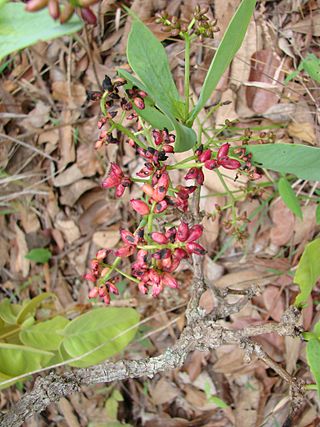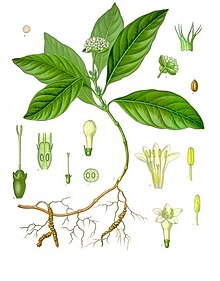
Hevea is a genus of flowering plants in the spurge family, Euphorbiaceae, with about ten members. It is also one of many names used commercially for the wood of the most economically important rubber tree, H. brasiliensis. The genus is native to tropical South America but is widely cultivated in other tropical countries and naturalized in several of them. It was first described in 1775.
Conceveiba is a plant genus of the family Euphorbiaceae, first described as a genus in 1775. It is native to South America and Central America.
- Conceveiba guianensisAubl. - Brazil, Peru, Bolivia, Ecuador, Colombia, Venezuela, 3 Guianas
- Conceveiba hostmaniiBenth. - Guyana, Suriname, Amazonas State in Brazil
- Conceveiba krukoffiiSteyerm. - Venezuela, French Guiana, NW Brazil
- Conceveiba latifoliaBenth. - Colombia, Venezuela, Peru, Amazonas State in Brazil
- Conceveiba martianaBaill. - Venezuela, French Guiana, NW Brazil, Colombia, Ecuador, Peru, Bolivia
- Conceveiba maynasensisSecco - Loreto in Peru
- Conceveiba parvifoliaMcPherson - Panama, NW Colombia
- Conceveiba pleiostemonaDonn.Sm. - Costa Rica, Nicaragua, Colombia, Venezuela
- Conceveiba praealta(Croizat) Punt ex J.Murillo - NW Brazil
- Conceveiba ptariana(Steyerm.) Jabl. - S Venezuela
- Conceveiba rhytidocarpaMüll.Arg. - Colombia, Ecuador, Peru
- Conceveiba santanderensisJ.Murillo - NW Colombia
- Conceveiba terminalis(Baill.) Müll.Arg. - Venezuela, Guyana, Suriname, NW Brazil, Colombia, Peru
- Conceveiba tristigmataJ.Murillo - Colombia, Venezuela, NW Brazil

Rauvolfia is a genus of evergreen trees and shrubs, commonly known as devil peppers, in the family Apocynaceae. The genus is named to honor Leonhard Rauwolf. The genus can mainly be found in tropical regions of Africa, Asia, Latin America, and various oceanic islands.

Tetrorchidium is a genus of flowering plants in the family Euphorbiaceae first described in 1841. It is native to tropical portions of Africa and the Western Hemisphere.

Pouteria is a genus of flowering trees in the gutta-percha family, Sapotaceae. The genus is widespread throughout the tropical Americas, with outlier species in Cameroon and Malesia. It includes the canistel, the mamey sapote, and the lucuma. Commonly, this genus is known as pouteria trees, or in some cases, eggfruits.

Caryocar is a genus of flowering plants, in the South American family Caryocaraceae described as a genus by Linnaeus in 1771. It is native primarily to South America with a few species extending into Central America and the West Indies.

Aegiphila is a genus of flowering plants in the mint family, Lamiaceae, first described in 1763. It was formerly classified in the Verbenaceae. It is native to Mexico, Central America, South America, the West Indies, and Florida.

Alseis is a genus of flowering plants in the family Rubiaceae. It was described by Heinrich Wilhelm Schott in 1827. The genus is native to tropical Latin America from southern Mexico to Brazil.

Neea is a genus of plants in family Nyctaginaceae from the Caribbean region, Central and South America. Members of the genus are commonly called Nia, Neea, or saltwood.

Renealmia is a plant genus in the family Zingiberaceae. Its members are native to tropical Africa and tropical America. In Peru, fruits and tubers are sources of indigenous dyes. and indigenous medical treatments for leishmania and malaria In Colombia, it is used to treat snakebite. Bracts and leaves can serve as phytotelmata, retaining small quantities of water that offer habitat for other organisms.

Chiococca is a genus of flowering plants in the family Rubiaceae. It currently holds 23 species that are native to Florida, Texas, Mexico, Central America, much of South America, the West Indies, and the islands of Galápagos and Fernando de Noronha.

Amaioua is a genus of flowering plants in the family Rubiaceae. It was first described by Jean Baptiste Aublet in 1775. The genus is native to tropical America from southern Mexico to Brazil, including Cuba and Trinidad.

Amphidasya is a genus of flowering plants in the family Rubiaceae. It was described by Paul Carpenter Standley in 1936. The genus is found in Central America and northern South America.
Appunia is a genus of flowering plants in the family Rubiaceae. It was described by Joseph Dalton Hooker in 1873. The genus is found from southern Mexico, Central America, and northern South America.

Chomelia is a genus of flowering plants in the family Rubiaceae. It is native to Mexico, Central America, the West Indies, and much of South America as far south as Argentina.

Ischnosiphon is a genus of plants native to Central America, South America, Trinidad and the Lesser Antilles. It was first described as a genus in 1859.

Coussarea is a genus of flowering plants in the family Rubiaceae. The genus is found from southern Mexico to tropical America.

Lacmellea is a genus of flowering plants in the family Apocynaceae first described as a genus in 1857. It is native to South America and Central America.
- Lacmellea abbreviataJ.F.Morales - Colombia
- Lacmellea aculeata(Ducke) Monach - Peru, NW Brazil, the Guianas
- Lacmellea arborescens(Müll.Arg.) Markgr. - Brazil, Bolivia
- Lacmellea bahiensisJ.F.Morales - Bahia
- Lacmellea costanensisSteyerm. - N Venezuela
- Lacmellea densifoliata(Ducke) Markgr. - Pará
- Lacmellea edulisH.Karst. - Panama, Venezuela, Colombia, Ecuador, Peru, Brazil
- Lacmellea floribunda(Poepp.) Benth. & Hook.f. - Peru, NW Brazil, Suriname, French Guiana
- Lacmellea foxii(Stapf) Markgr. - Peru
- Lacmellea gracilis(Müll.Arg.) Markgr. - N Peru, NW Brazil
- Lacmellea guyanensis(Müll.Arg.) Monach - French Guiana
- Lacmellea klugiiMonach. - Peru
- Lacmellea macranthaJ.F.Morales - Ecuador
- Lacmellea microcarpa(Müll.Arg.) Markgr. - Colombia, S Venezuela, NW Brazil
- Lacmellea oblongataMarkgr. - SE Colombia, Ecuador, Peru
- Lacmellea panamensis(Woodson) Markgr. - Costa Rica, Panama, Colombia, Ecuador
- Lacmellea pauciflora(Kuhlm.) Markgr. - Brazil
- Lacmellea peruviana(Van Heurck & Müll.Arg.) Markgr. - Peru
- Lacmellea pygmaeaMonach. - Amazonas State in Venezuela
- Lacmellea ramosissima(Müll.Arg.) Markgr. - Colombia, S Venezuela, NW Brazil
- Lacmellea speciosaWoodson - Costa Rica, Panama, Colombia, Ecuador, Peru
- Lacmellea standleyi(Woodson) Monach. - Belize, Guatemala, Honduras
- Lacmellea utilis(Arn.) Markgr. - S Venezuela, Guyana
- Lacmellea zamoraeJ.F.Morales - Costa Rica

Odontadenia is a genus of plant in the family Apocynaceae, first described as a genus in 1841. It is native to southern Mexico, Central America, South America, and the West Indies.
- Odontadenia anomala(Van Heurck & Müll.Arg.) J.F.Macbr. - Peru, Bolivia
- Odontadenia campanulataJ.F.Morales - Colombia
- Odontadenia funigeraWoodson - Venezuela, Colombia, Ecuador, Peru, Brazil
- Odontadenia geminata(Hoffmanns. ex Roem. & Schult.) Müll.Arg. - 3 Guianas, Venezuela, Colombia, Ecuador, Peru, Bolivia, N Brazil
- Odontadenia glaucaWoodson - Amazonas State in S Venezuela
- Odontadenia gracilipes(Stadelm.) Woodson - Minas Gerais
- Odontadenia hypoglauca(Stadelm.) Müll.Arg. - Bolivia, Brazil
- Odontadenia killipiiWoodson - French Guiana, Venezuela, Colombia, Ecuador, Peru, N Brazil
- Odontadenia kochiiPilg. - Guyana, Venezuela, Colombia, Ecuador, Peru, N Brazil
- Odontadenia laxiflora(Rusby) Woodson - Peru, Bolivia, N Brazil
- Odontadenia lutea(Vell.) Markgr. - Peru, Bolivia, Brazil
- Odontadenia macrantha(Roem. & Schult.) Markgr. - Oaxaca, Chiapas, Central America, Trinidad & Tobago, 3 Guianas, Venezuela, Colombia, Ecuador, Peru, Brazil
- Odontadenia markgrafianaJ.F.Morales - French Guiana, N Brazil
- Odontadenia matogrossanaJ.F.Morales - Goiás, Mato Grosso
- Odontadenia nitida(Vahl) Müll.Arg. - Trinidad & Tobago, 3 Guianas, Venezuela, Colombia, Ecuador, Peru, Brazil, Bolivia
- Odontadenia perrottetii(A.DC.) Woodson - Venezuela, Colombia, Brazil, Bolivia, Guyana, French Guiana
- Odontadenia polyneura(Urb.) Woodson - Hispaniola
- Odontadenia puncticulosa(Rich.) Pulle - Central America, 3 Guianas, Venezuela, Colombia, Ecuador, Peru, Brazil, Bolivia
- Odontadenia stemmadeniifoliaWoodson - Venezuela, Colombia, Ecuador, Peru, Brazil
- Odontadenia verrucosa(Willd. ex Roem. & Schult.) K.Schum. ex Markgr. - 3 Guianas, Venezuela, Colombia, Ecuador, Peru, Brazil, Bolivia, Panama, Costa Rica, Nicaragua
- Odontadenia cuspidataRusby = Mandevilla cuspidata(Rusby) Woodson
- Odontadenia duckeiMarkgr. = Mandevilla pohliana(Stadelm.) A.H.Gentry
- Odontadenia glandulosa(Ruiz & Pav.) K.Schum. = Mandevilla glandulosa(Ruiz & Pav.) Woodson
- Odontadenia macrocalyx(Müll.Arg.) Miers = Tabernaemontana macrocalyxMüll.Arg.

















